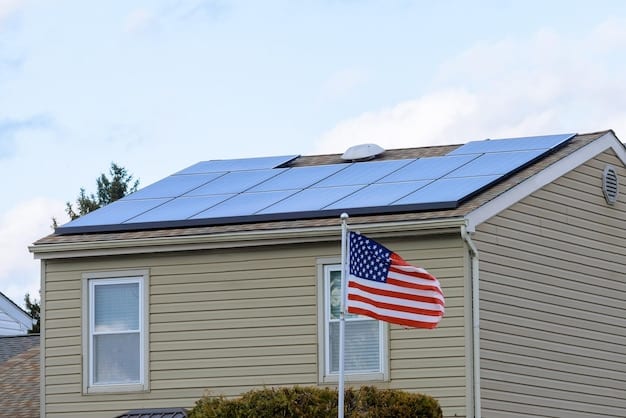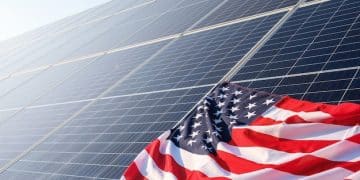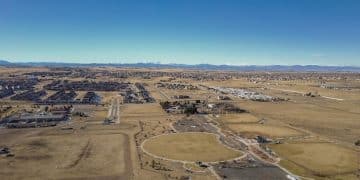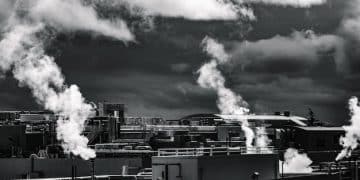Federal Climate Initiatives: Key Actions & Timelines Explained

The federal response to climate change involves a variety of key initiatives, including setting emissions reduction targets, investing in renewable energy technologies, and implementing regulations to limit pollution, all with specific timelines for achieving measurable progress.
Navigating the complex landscape of climate change can be daunting, especially when trying to understand the government’s role. This article breaks down the federal response to climate change: what are the key initiatives and their timelines? By exploring current strategies, targets, and future projections, we aim to provide a clear picture of the United States’ commitment to environmental sustainability.
Understanding the Urgency of Climate Action
Climate change is no longer a distant threat; it’s a present reality impacting communities across the globe. Rising temperatures, extreme weather events, and sea-level rise are just some of the consequences that demand immediate and comprehensive action. Understanding the urgency is crucial for grasping the scope and importance of the federal response.
The scientific consensus on climate change is overwhelming. Reports from organizations like the Intergovernmental Panel on Climate Change (IPCC) consistently highlight the need for drastic reductions in greenhouse gas emissions. The longer we delay, the more severe and irreversible the impacts will become.
Key Findings on Climate Change
Understanding the specifics of what’s happening can help underscore the need for a strong federal response.
- Rising Temperatures: Global average temperatures are steadily increasing, leading to heatwaves and altered ecosystems.
- Extreme Weather: More frequent and intense hurricanes, droughts, and floods are becoming the new normal.
- Sea-Level Rise: Melting glaciers and ice sheets are causing sea levels to rise, threatening coastal communities.
Ignoring these findings is not an option. The federal government’s actions are designed to mitigate and adapt to these changes, aiming to protect both the environment and the economy.
Acknowledging the urgency sets the stage for understanding the various initiatives and timelines that the U.S. government has put in place to address this critical issue. These efforts are not just about environmental protection; they’re about ensuring a sustainable future for generations to come.
Setting the Stage: Federal Climate Change Policies
The federal government plays a pivotal role in shaping climate policy through legislation, executive orders, and international agreements. These policies provide the framework for concrete actions designed to reduce greenhouse gas emissions and promote sustainability. It’s essential to understand the foundational policies that drive climate action in the United States.
Over the years, various administrations have introduced different approaches to climate change. From cap-and-trade systems to investments in renewable energy, federal policies have evolved in response to changing scientific understanding and political priorities.

Here’s a look at some key legislative milestones:
- Clean Air Act: While not solely focused on climate change, this act provides the EPA with the authority to regulate air pollutants, including greenhouse gases.
- Energy Policy Act: This act has been updated multiple times, each iteration promoting different energy sources and efficiency standards.
- Inflation Reduction Act: Includes historic investments in clean energy and climate resilience.
These policies, along with numerous executive actions, reflect a growing recognition of the need for federal intervention. Understanding these broad strokes is crucial for evaluating their impact and effectiveness.
By setting the stage with these fundamental policies, the federal government aims to drive change across all sectors of the economy, from energy production to transportation and agriculture. Clear goals and consistent frameworks are essential for achieving long-term success in mitigating climate change.
The Biden Administration’s Climate Agenda
The Biden administration has placed climate change at the forefront of its agenda, setting ambitious goals and initiating significant actions to address the crisis. A central component is the commitment to rejoining the Paris Agreement, signaling the U.S.’s renewed dedication to international cooperation on climate issues.
President Biden has outlined specific targets for emissions reductions, aiming to achieve a 50-52% reduction from 2005 levels by 2030. This ambitious goal necessitates a comprehensive approach involving multiple sectors and stakeholders.
Key Initiatives Under the Biden Administration
Several specific initiatives are underway to meet these ambitious targets. They include:
- Investing in Clean Energy: Massive investments in renewable energy sources such as solar, wind, and geothermal.
- Boosting Energy Efficiency: Programs and incentives to improve energy efficiency in buildings, transportation, and industry.
- Environmental Justice: Prioritizing climate solutions that benefit disadvantaged communities and address environmental inequities.
These initiatives are designed not only to reduce emissions but also to create new jobs and stimulate economic growth in clean energy sectors. The Biden administration’s approach emphasizes that climate action and economic prosperity can go hand in hand.
The success of the Biden administration’s climate agenda hinges on its ability to implement these initiatives effectively and to secure the necessary support from Congress and the public. The timeline for these actions is critical, with each step bringing the U.S. closer to achieving its long-term climate goals.
Key Climate Initiatives and Their Timelines
To effectively combat climate change, the federal government has launched several key initiatives, each with its own timeline for implementation and projected outcomes. Understanding these timelines is essential for tracking progress and holding policymakers accountable.
These initiatives span various sectors, from energy and transportation to agriculture and conservation. They include regulatory actions, funding programs, and partnerships with states, local governments, and the private sector.

Here’s a snapshot of some key initiatives and their projected timelines:
- Transition to Electric Vehicles: Setting targets for electric vehicle adoption, with the goal of phasing out gasoline-powered vehicles by a certain date.
- Renewable Energy Standards: Establishing renewable portfolio standards that require utilities to generate a certain percentage of their electricity from renewable sources.
- Methane Emissions Reduction: Implementing regulations to reduce methane emissions from oil and gas operations.
These timelines are not set in stone and may be subject to change based on technological advancements, economic conditions, and political considerations. Regular monitoring and evaluation are necessary to ensure that these initiatives remain on track and are achieving their intended goals.
By examining these key initiatives and their timelines, stakeholders can gain a clearer understanding of the federal government’s strategy for addressing climate change. This knowledge is crucial for informed participation in the policy process and for advocating for more ambitious and effective climate action.
Challenges and Obstacles
Despite ambitious goals and well-intentioned initiatives, the federal response to climate change faces numerous challenges and obstacles. These challenges can hinder progress and undermine the effectiveness of climate policies.
One of the biggest challenges is political polarization. Climate change has become a highly partisan issue, with significant disagreement over the severity of the problem and the appropriate course of action.
Key Challenges in Implementing Climate Policies
Here are some specific obstacles that policymakers must overcome:
- Political gridlock: Difficulty in passing comprehensive climate legislation due to partisan divisions.
- Economic concerns: Fears about the economic impacts of climate policies, particularly on industries reliant on fossil fuels.
- Legal challenges: Lawsuits challenging the legality of climate regulations.
Overcoming these challenges requires a multi-faceted approach involving bipartisan cooperation, public education, and innovative policy solutions. It also requires addressing legitimate concerns about economic competitiveness and job creation.
Despite these obstacles, there is reason for optimism. Technological advancements are making renewable energy more affordable and accessible, and a growing number of businesses and communities are embracing sustainable practices. By working together and addressing the challenges head-on, the U.S. can overcome these obstacles and achieve its climate goals.
The Road Ahead: Future Directions in Federal Climate Policy
Looking ahead, the federal government must continue to evolve its climate policies to meet the growing challenges of climate change. This requires embracing innovative solutions, fostering international cooperation, and engaging all sectors of society.
One promising direction is the development of carbon capture and storage technologies. These technologies have the potential to significantly reduce emissions from fossil fuel power plants and other industrial facilities.
Future Success Leans on these Elements:
- Technological innovation: Investing in research and development of new climate technologies.
- International collaboration: Working with other countries to achieve global climate goals.
- Public engagement: Engaging the public in the climate conversation and empowering individuals to take action.
Ultimately, the success of federal climate policy will depend on the willingness of policymakers to prioritize long-term sustainability over short-term political gains. It will also require a commitment to environmental justice, ensuring that all communities benefit from climate solutions.
By setting ambitious goals, investing in innovative solutions, and fostering collaboration, the federal government can lead the way towards a cleaner, more sustainable future.
| Key Point | Brief Description |
|---|---|
| 🎯 Emissions Targets | Goals to reduce greenhouse gas emissions by 50-52% by 2030. |
| ⚡ Clean Energy Investments | Funding for solar, wind, and other renewable energy sources. |
| 🌱 Energy Efficiency | Programs to improve energy use in buildings and transportation. |
| ⚖️ Regulations | Rules to limit methane emissions from oil and gas operations. |
Frequently Asked Questions
▼
The primary goal is to reduce greenhouse gas emissions significantly. This is meant to mitigate the impacts of climate change by investing in renewable energy and promoting energy efficiency nationwide.
▼
The US aims to achieve these targets by transitioning to clean energy, boosting energy efficiency, and implementing regulations to curb emissions from various sectors, including transportation and industry.
▼
International cooperation is crucial. The US works with other nations through agreements like the Paris Agreement to collectively address climate change, sharing knowledge, and coordinating efforts to reduce global emissions.
▼
Economic challenges include the cost of transitioning to clean energy, potential impacts on fossil fuel industries, and ensuring that climate policies do not disproportionately affect low-income communities.
▼
Individuals can make a difference by adopting energy-efficient practices, supporting sustainable businesses, advocating for climate-friendly policies, and educating themselves and others about the importance of climate action.
Conclusion
The federal response to climate change is a multifaceted effort involving ambitious goals, key initiatives, and specific timelines. While significant challenges remain, the U.S. is committed to achieving a sustainable future through investment in clean energy, regulatory actions, and international cooperation.





